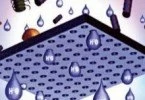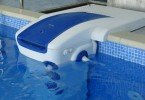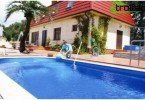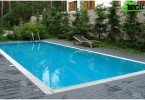Pool ventilation and dehumidifiers
The room in which the pool is located is exposed to the negative effects of high humidity. Excess moisture settles on the ceiling, floor, windows, walls, metal structures and leads to the formation of corrosion, mold, the development of bacteria and the destruction of the interior decoration. Water vapor adversely affects the equipment used, the result is a decrease in the working life of the swimming pool technological systems. In addition, adverse conditions are created for the people present. To ensure a favorable climate in the pool room and compliance with sanitary standards, specialized equipment is used: forced ventilation and a dehumidifier for the pool.
Maintaining an optimal level of humidity is possible only when using these methods in combination.
Content
- Ventilation systems for pools
- Separate supply and exhaust ventilation
- Supply and exhaust system with recovery
Ventilation systems for pools
The main task of ventilation is to eliminate excess moisture in the pool. It evaporates, both from the surface of the pool, and from wet fences, the bodies of bathing people. In this situation, the supply and exhaust ventilation of the pool is a prerequisite for its functioning..
Important! Supply air should not blow around the surface of the water, as this causes an increase in water evaporation and its rapid cooling in the pool.
At the design stage of the ventilation system, it should be noted that to reduce evaporation from the surface of the pool, the temperature in the room should be 2-3 degrees higher than the existing water temperature. Relative humidity is best maintained at 55-60%.
In practice, two methods are used with which the supply and exhaust ventilation of the pools is carried out:
- Separate systems of supply and exhaust ventilation, which operate simultaneously;
- Supply and exhaust system with heat recovery.
Separate supply and exhaust ventilation
The separate system is characterized by the integrated operation of the supply and exhaust ventilation systems. The application of this method is characterized by a cheaper cost of equipment, however, it is characterized by rather high operating costs. To organize such a ventilation system for the pool requires a significant area for the installation of installations.
This system provides fresh air from the street and the simultaneous removal of moist air from the pool. The installation of ventilation equipment is carried out together with civil works.
The exhaust system is represented by an exhaust fan built into special exhaust ducts.
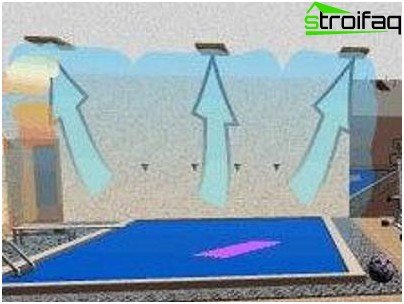
Exhaust ventilation system removes excess moisture through special exhaust ducts
The supply system consists of the following components:
- A device for air intake with a valve that does not let cold air pass in winter with the fan turned off;
- Filter for purification of incoming atmospheric air;
- Heater for outdoor air used in the cold season;
- Accessory fan for organizing air supply to the pool room;
- Control unit for temperature and volume of air supply.
An important point that requires attention when designing a ventilation system is the availability of an automation system. It is able to constantly monitor the room temperature and maintain it at a given level, controls the pressure drop between adjacent rooms and the pool, ensures compliance with the necessary parameters of air flow.
Supply and exhaust system with recovery
The supply and exhaust system with an integrated heat recuperator operates in one unit. This method has significant costs at the stage of equipment procurement, but operating costs will be less than for a cheaper separate supply and exhaust system.
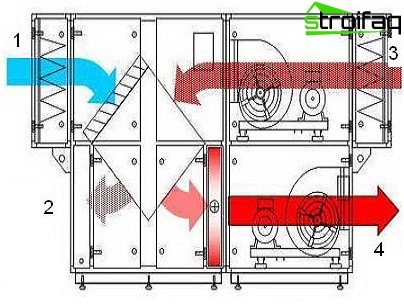
Supply and exhaust ventilation system with heat recovery: 1 – fresh air; 2 – exhaust air; 3 – from the pool; 4 – to the pool
The indisputable advantages of its use are:
- Save space indoors. The supply and exhaust system located in one unit requires less space for placement than a separate system. This moment plays an important role when choosing a ventilation system for a small pool..
- Energy saving. Using a built-in recuperator in the system allows energy savings of up to 50-70% due to the fact that the supply air is heated using exhaust air flow, but they do not mix. This feature allows you to reduce the power of the built-in engine by 2-2.5 times.
The main elements of this system include:
- Supply and exhaust fan;
- Cleaning filter for outdoor air;
- Double valve that prevents the penetration of cold air when the unit is turned off;
- Heat recuperator;
- Heater for heating the incoming air to a predetermined temperature, located behind the recuperator.
A single supply and exhaust system is equipped with automatic temperature and humidity control, in addition, it can be additionally equipped with devices for distributing heated air to other rooms.
To create and maintain an ideal climate, additional specialized equipment, such as pool dehumidifiers, should be used..
Dehumidifiers for pools
The main purpose of air dryers is to maintain optimal humidity in the pool.
Using dehumidifiers for swimming pools can significantly reduce the energy consumption for heating outdoor air, since most of the moisture can be removed using this equipment, avoiding its mechanical removal together with the air. The main disadvantage of using only a desiccant is the inability to remove unpleasant odors. This problem can be easily solved by sharing the supply and exhaust ventilation..
A variety of modifications allows you to choose a dehumidifier for the pool, taking into account the specific use case. There are stationary and mobile, floor and wall models.
The main parameters when choosing a high-quality dehumidifier are efficiency, productivity, reliability, high protection against moisture. The main elements of this equipment are made of anti-corrosion materials.
Modern models of air dehumidifiers for swimming pools work on one of the following principles:
- Condensation;
- Assimilation;
- Adsorption.
Condensation principle
The process of operation of air dehumidifiers, based on the principle of condensation, consists in the accumulation of water vapor in the air on a special surface with a lower temperature. The mechanism of action is the same as that of an air conditioner, but heat is not removed from the room.
The principle of operation of the devices is as follows: when air interacts with a cooled surface, moisture condensation occurs. The fan directs humid air from the pool to the evaporator, where it cools and condenses, which is then removed to a special container or through a drain. Further, the air enters the condenser, heats up to a predetermined temperature and enters back into the pool. Dryer operation is automatic.
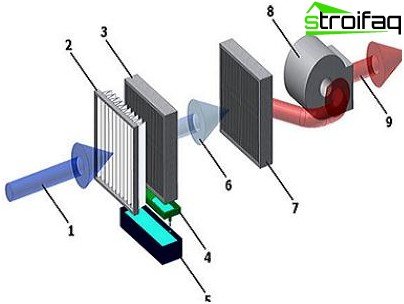
Condensation drainage: 1 – moist air; 2 – filter; 3 – evaporator; 4 – pallet for stacks; 5 – container for condensate; 6 – drained and cooled air; 7 – capacitor; 8 – fan; 9 – drained and heated air
The effectiveness of condensing dehumidifiers is more dependent on the initial room temperature.
Adsorption Drying
The work of adsorption dryers is to remove moisture from the air masses using a special absorber – adsorbent. The air in the room forcibly passes through the desiccant chamber, which contains the adsorbent. Next, moisture is absorbed by an effective adsorbent on a fiberglass basis and the return of treated air to the pool room.
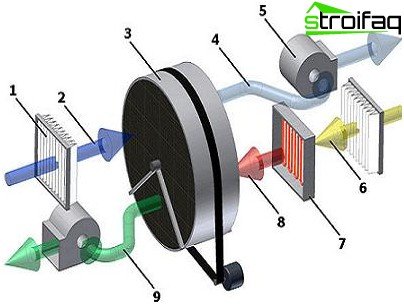
Adsorption drainage: 1 – filter; 2 – moist air; 3 – rotor; 4 – dried air; 5 – fan; 6 – regenerative air; 7 – heater; 8 – hot regenerative air; 9 – moist regenerative air
These pool dehumidifiers are highly efficient and productive. The design of the adsorption rotor allows you to simultaneously pass two parallel air flows. One stream directs the treated and dried air into the room, and an additional hot air stream removes moisture from the adsorbent. Continuous rotation of the rotor provides continuous drainage of moist air and simultaneous regeneration of the adsorbent.
Assimilation air dryer
Dehumidifiers using the principle of assimilation are characterized by low productivity and efficiency, high energy costs. The principle of assimilation is that heated air will interfere with more water vapor than cold. This type of dehumidifier is practically not used to drain the pools, since their operation largely depends on the ambient temperature. Assimilation dehumidifiers do not provide an effective result in rooms with high relative humidity.
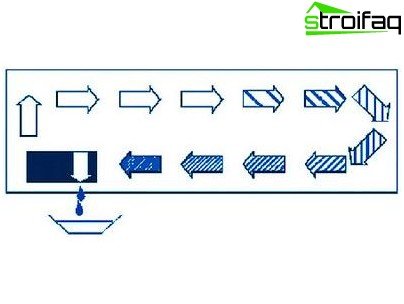
The assimilation principle of the dehumidifier
When choosing a dehumidifier, it is necessary to pay attention to vibration resistance and noise level during operation. These parameters have an important effect on the comfort of people present in the pool, as the equipment is designed for continuous operation without shutting down..
With the proper organization of pool ventilation and air drainage, comfortable conditions are created for people present, and the life of the building as a whole increases. Using a full range of measures allows you to achieve the necessary influx of fresh air and avoid high humidity. Creating a favorable microclimate in the pool is only possible when achieving the perfect balance between air temperature and humidity.


